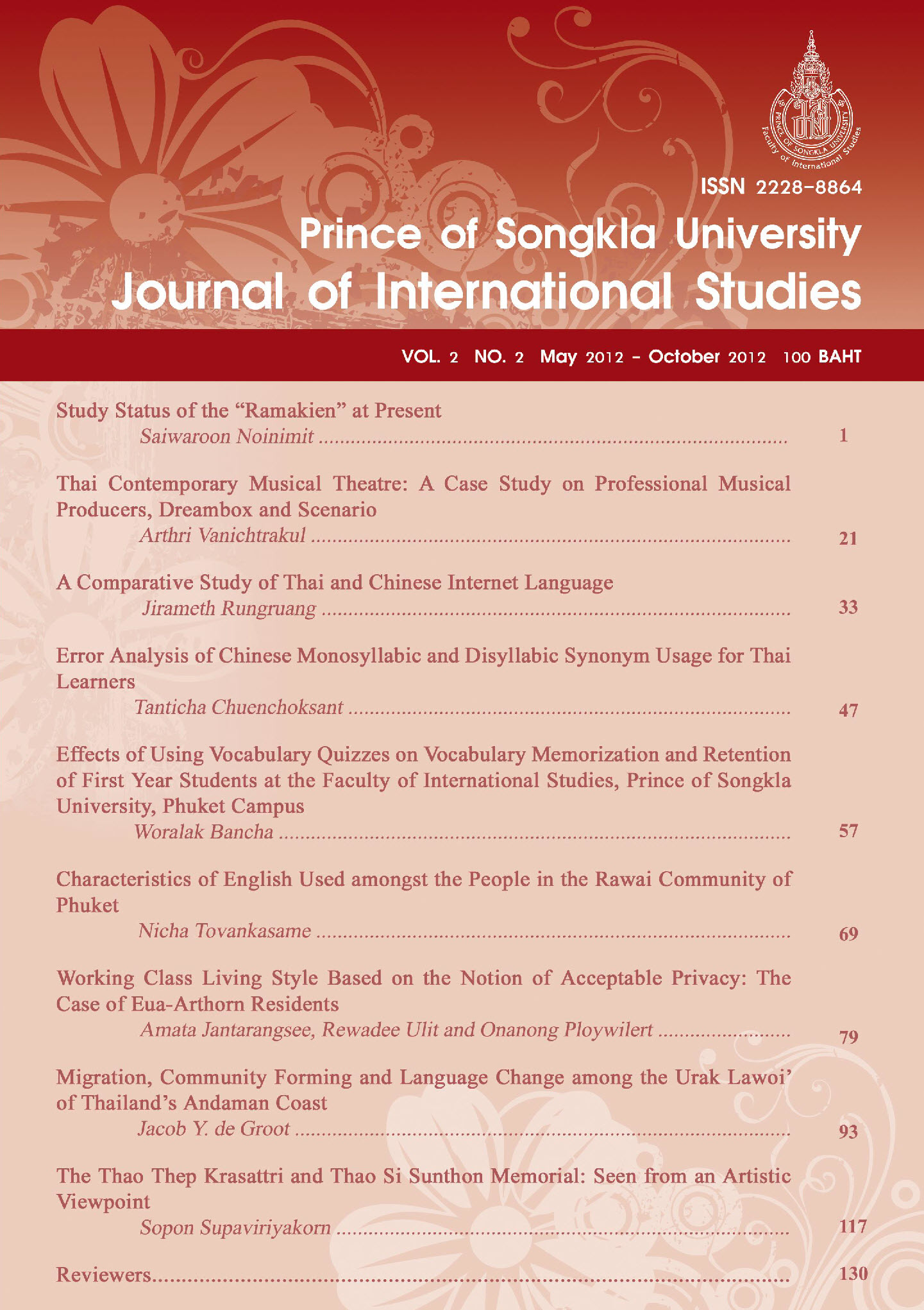Characteristics of English Used amongst the People in the Rawai Community of Phuket
Main Article Content
Abstract
This study focuses on the characteristics of spoken English by the people in a community located in Phuket called Rawai, by comparing the syntactic and lexical features to the standard English. The total amount of informants was 28, consisting of a group of traders and inter-married families. Data was tape-recorded by using the techniques of observer as-participant and complete participant. Later on, the recorded conversations were transcribed and analyzed.
The results illustrate that English use among Rawai people was different from those of the standard English, as seen in the aspects of grammar, word order, and word choice. Those characteristics also correspond to what has been suggested in previous studies of pidgin in sociolinguistics, that is pidgin speakers use English vocabulary in Thai syntax. For example, You buy my shirt quick quick madam. (You should buy my shirt quickly.). It was also found that their second language usage reflects the experience of language learning from the real situation because of their necessity of living and trading. Interestingly, the linguistic usage found demonstrates the influence of the first language on constructing another language, and further shows the self-creation of sentence structure and lexicon.
Article Details
Statements and opinions expressed in articles herein are those of the authors and do not necessarily reflect the position of the editors or publisher.
Article, information, text, image, etc. which are published in Journal of International Studies, belong to Journal of International Studies. If anybody or any organization would like to use part or whole of them, they must receive written permission from Journal of International Studies before usage.
References
Sukhumvit Road, Bangkok. Science of Language, 9. ภัทรพร หิรัญภัทร์. (2547), การเรียนรู้และการใช้ภาษาอังกฤษของพนักงานหญิงในสถานบันเทิง
ย่านพัฒน์พงศ์, วิทยานิพนธ์ปริญญามหาบัณฑิต ไม่ได้ตีพิมพ์, สาขาวิชาภาษาศาสตร์
เพื่อการสื่อสาร คณะศิลปศาสตร์ มหาวิทยาลัยธรรมศาสตร์, Hirunpat, P. (2004). English language learning and the use of english by female
employees of entertainment establishments in Patpong. Unpublished master's thesis. Department of Linguistics for Communications, Faculty of Liberal Arts
Thammasat University, Thailand. สุปัญญา ชมจินดา. (2538), กลวิธีในการใช้ภาษาอังกฤษเพื่อการขายสินค้าของผู้ค้าแบบแผงลอย
ชาวไทยย่านถนนข้าวสารกรุงเทพมหานคร. วิทยานิพนธ์ปริญญามหาบัณฑิต ไม่ได้ตีพิมพ์ คณะศิลปศาสตร์, มหาวิทยาลัยธรรมศาสตร์
Chomchinda, S. (1995). English sales talk in Bangkok: Communicative Strategies of
Khaosan Road Stall Vendors. Unpublished master's thesis, Faculty of Liberal-Arts
Thammasat University, Thailand. Adler, M. (1977). Pidgins, Creoles and Lingua Francas: A Sociolinguistic Study.
Hamburg, Germany: Helmut Buske Verlag. Allen, J.H. (1992). Former Lexifier Language Acquisition. Work papers of the Summer
Institute of Linguistics in St. Lucia. Dulay, H., Burt, M. And Krashen, S. (1982). Language Two., Oxford, U.K: Oxford
University Press Hudson, R.A. (1980). Sociolinguistics., Cambridge, U.K.: Cambridge University Press. Kirkpatrick, A. (2010). English as a lingual Franca in ASEAN: A Multilingual Model.,
tu Singapore: National University of Singapore Press. Mauranen, A. and Elina Ranta. (2009). English as a Lingua Franca: Studies and Findings.,
Newcastle, U.K.: Cambridge Scholars Publishing. Mcneill, D. (1987). Psycholinguistics: A New Approach., New York, U.S.A.: Harper &
Row Publishers. Speyer, A. 2010. Topicalization and stress class avoidance in the history of english.,
Berlin, Germany: De Gruyter Mouton. Thomason, G. S. (2001). Language Contact: An Introduction., Washington D.C., U.S.A:
Georgetown University Press. Todd, L. (1974). Pidgins and Creoles. London and Boston: Routledge. Wardhaugh, R. (2002). An introduction to sociolinguistics., Oxford, U.K.: Blackwell
Publishing.


